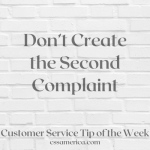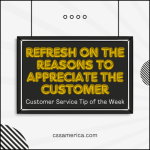
Why is Customer Service Week important? It’s an opportunity to recognize wonderful staff, convey appreciation to customers, and reinforce the great that customer service can do for organizational success.
To that last point, here are the Top 10 ways that Customer Service Teams benefit the organization:
- Issue-resolution – They fix problems that are created elsewhere in the organization by addressing customer issues with company products, processes, and people.
- Collaboration – Customer Service Teams bridge the gaps between siloed departments to bring all the corporate tools and resources together to meet the client’s needs.
- Relationship-building – They grow relationships with customers, creating an affinity for the organization all while customers may be complaining about the product.
- Maximize Revenue – Customer Retention reduces lost revenue, so great Customer Service Teams make life easier for Marketing and Sales departments who don’t have to uncover as much new business tomorrow because of business lost today.
- Positivity – They create a more balanced environment of positivity, recognition, and relationship-building in organizations that would otherwise focus almost exclusively on accountability and cost-control.
- Long-term Thinking – Great Customer Service Teams help foster a long-term, retention-culture in organizations often overrun with short-term thinking.
- Continuous Improvement – They identify recurring issues, and share those with others in the organization to uncover permanent solutions.
- Drive Innovation – Customer Service Teams are continuously learning what issues, needs, goals, and trends customers have – and how they’re changing. These employees can serve as the “Voice of the Customer,” identifying changes in customer wants and needs that drive innovation.
- Competitive Advantage – Great customer service is a huge differentiator for companies, especially those where products or pricing varies little from business-to-business.
- Reputation – Great Customer Service Teams make your business look good. They’re often the “last impression” after a product purchase – when there’s a question, concern, issue, or need for follow-up.
Recognize the great Customer Service Teams that make your organization a greater success!
Signup for FREE Tips! Contact Us More Resources for You Visit Our Home Page























